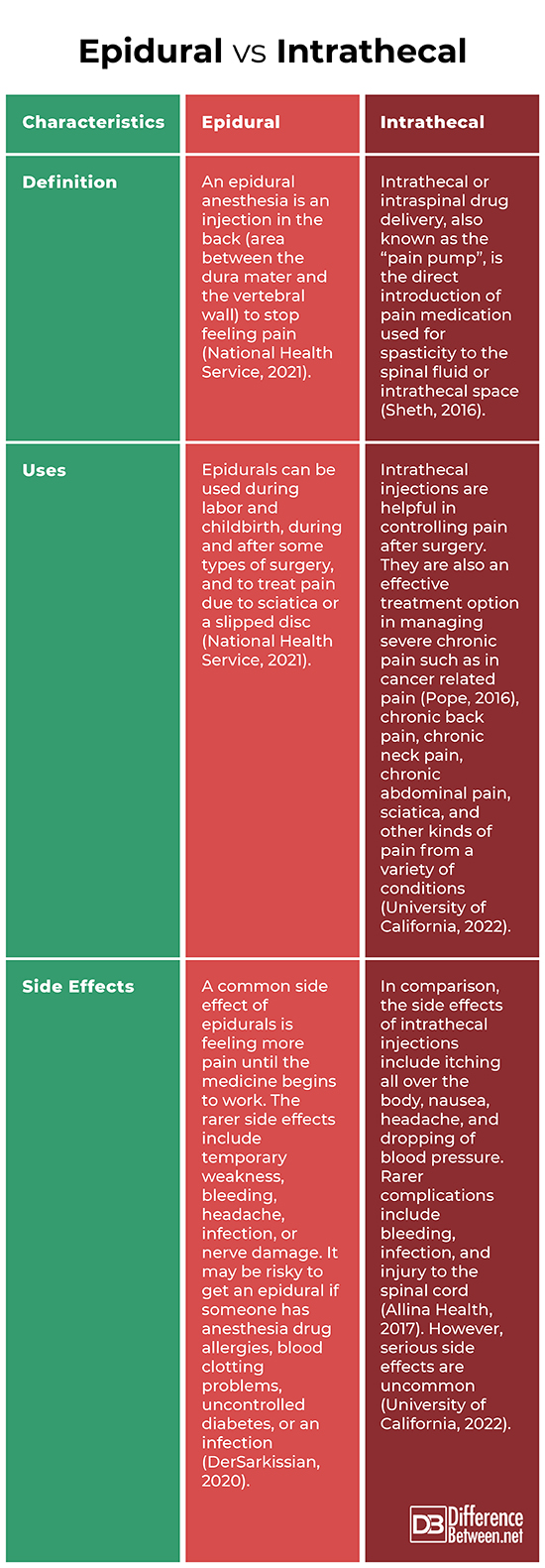Difference Between Epidural and Intrathecal
Both epidural and intrathecal administrations are for pain management and involve the lower back. Specifically, epidural anesthesia is an injection in the area between the dura mater and the vertebral wall while intrathecal or intraspinal drug delivery is the direct introduction of pain medication used for spasticity to the spinal fluid. The subsequent discussions further look into their distinctions.

What is Epidural?
An epidural anesthesia is an injection in the back (area between the dura mater and the vertebral wall) to stop feeling pain. It can be used during labor and childbirth, during and after some types of surgery, and to treat pain due to sciatica or a slipped disc (National Health Service, 2021). This is administered by a physician anesthesiologist who will insert a needle and a catheter in the lower part of the back which was numbed. The needle is then removed, and the tiny tube (catheter) is left in place for medication delivery. Epidural anesthesia creates a band of numbness from the bellybutton to the upper legs (American Society of Anesthesiologists, 2021).
A common side effect is feeling more pain until the medicine begins to work. The rarer side effects include temporary weakness, bleeding, headache, infection, or nerve damage. It may be risky to get an epidural if someone has anesthesia drug allergies, blood clotting problems, uncontrolled diabetes, or an infection (Der Sarkissian, 2020).

What is Intrathecal?
Intrathecal or intraspinal drug delivery is the direct introduction of pain medication used for spasticity to the spinal fluid or intrathecal space. It is also known as the “pain pump”; a small pump is surgically placed under the abdominal skin, and it delivers the medication via a catheter to the area around the spinal cord. The intrathecal space is usually accessed from the lower back (Sheth, 2016; University of California, 2022).
One intrathecal injection of narcotic medicine can last up to 24 hours; it is helpful in controlling pain after surgery. It is also an effective treatment option in managing severe chronic pain such as in cancer related pain (Pope, 2016), chronic back pain, chronic neck pain, chronic abdominal pain, sciatica, and other kinds of pain from a variety of conditions (University of California, 2022).
The side effects include itching all over the body, nausea, headache, and dropping of blood pressure. Rarer complications include bleeding, infection, and injury to the spinal cord (Allina Health, 2017). However, serious side effects are uncommon (University of California, 2022).
Difference between Epidural and Intrathecal
Definition
An epidural anesthesia is an injection in the back (area between the dura mater and the vertebral wall) to stop feeling pain (National Health Service, 2021). In comparison, intrathecal or intraspinal drug delivery, also known as the “pain pump”, is the direct introduction of pain medication used for spasticity to the spinal fluid or intrathecal space (Sheth, 2016).
Uses
Epidurals can be used during labor and childbirth, during and after some types of surgery, and to treat pain due to sciatica or a slipped disc (National Health Service, 2021). As for intrathecal injections, they are helpful in controlling pain after surgery. They are also an effective treatment option in managing severe chronic pain such as in cancer related pain (Pope, 2016), chronic back pain, chronic neck pain, chronic abdominal pain, sciatica, and other kinds of pain from a variety of conditions (University of California, 2022).
Side Effects
A common side effect of epidurals is feeling more pain until the medicine begins to work. The rarer side effects include temporary weakness, bleeding, headache, infection, or nerve damage. It may be risky to get an epidural if someone has anesthesia drug allergies, blood clotting problems, uncontrolled diabetes, or an infection (DerSarkissian, 2020). In comparison, the side effects of intrathecal injections include itching all over the body, nausea, headache, and dropping of blood pressure. Rarer complications include bleeding, infection, and injury to the spinal cord (Allina Health, 2017). However, serious side effects are uncommon (University of California, 2022).
Epidural vs Intrathecal

Frequently Asked Questions:
What is the difference between epidural and spinal?
The main difference is the location; epidural anesthesia is injected into the epidural space (area between the dura mater and the vertebral wall) and the pain relief usually occurs after 10 to 15 minutes. On the other hand, spinal anesthesia is injected into the dural sac that contains cerebrospinal fluid and there is immediate pain relief (Lewis, 2020).
Is epidural the same as lumbar puncture?
An epidural is an injection in the back to stop feeling pain in a part of the body. On the other hand, lumbar puncture is the insertion of a thin needle between the bones in the lower spine to take cerebrospinal fluid sample, inject medicine, inject anesthesia, or remove fluid to reduce pressure in the spine or skull (National Health Service, 2021).
What is intrathecal drug delivery?
Intrathecal or intraspinal drug delivery is the direct introduction of pain medication used for spasticity to the spinal fluid or intrathecal space. It is also known as the “pain pump”; a small pump is surgically placed under the abdominal skin, and it delivers the medication via a catheter to the area around the spinal cord (Sheth, 2016; University of California, 2022).
What is the difference between epidural analgesia and anesthesia?
Epidural analgesia is defined as a form of pain relief which is administered through the space surrounding the dural sheath while anesthesia is a loss of sensation (Fyneface-Ogan, 2012). Moreover, there are four types of anesthesia: general (renders the patient temporarily unconscious), regional (only a body part is numbed like epidurals), local (to numb a small site), and monitored anesthesia care (MAC) which is for outpatient procedures to make the patient feel sleepy and relaxed (Whitlock, 2021).
Summary
- An epidural anesthesia is an injection in the back (area between the dura mater and the vertebral wall) to stop feeling pain (National Health Service, 2021).
- Intrathecal or intraspinal drug delivery, also known as the “pain pump”, is the direct introduction of pain medication used for spasticity to the spinal fluid or intrathecal space (Sheth, 2016).
- Epidurals can be used during labor and childbirth, during and after some types of surgery, and to treat pain due to sciatica or a slipped disc (National Health Service, 2021).
- Intrathecal injections are helpful in controlling pain after surgery and in managing severe chronic pain (University of California, 2022).
- Difference Between Hematoma and Melanoma - February 9, 2023
- Difference Between Bruising and Necrosis - February 8, 2023
- Difference Between Brain Hematoma and Brain Hemorrhage - February 8, 2023
Search DifferenceBetween.net :
Leave a Response
References :
[0]Allina Health (2017). Intrathecal injection. https://www.allinahealth.org/health-conditions-and-treatments/health-library/patient-education/understanding-your-colon-or-rectal-surgery/surgery-hospital-stay-and-beyond/intrathecal-injection
[1]DerSarkissian, C. (2020). What is an epidural. WebMD. https://www.webmd.com/back-pain/what-is-an-epidural
[2]Fyneface-Ogan, S. (2012). Epidural analgesia-current views and approaches. Intech Open. https://www.intechopen.com/books/1731
[3]National Health Service (2021). Epidural. https://www.nhs.uk/conditions/epidural/#:~:text=An%20epidural%20is%20an%20injection,in%20some%20types%20of%20surgery.
[4]Pope, J. (2016). Clinical uses of intrathecal therapy and its placement in the pain care algorithm. Pain Practice. https://pubmed.ncbi.nlm.nih.gov/26914961/
